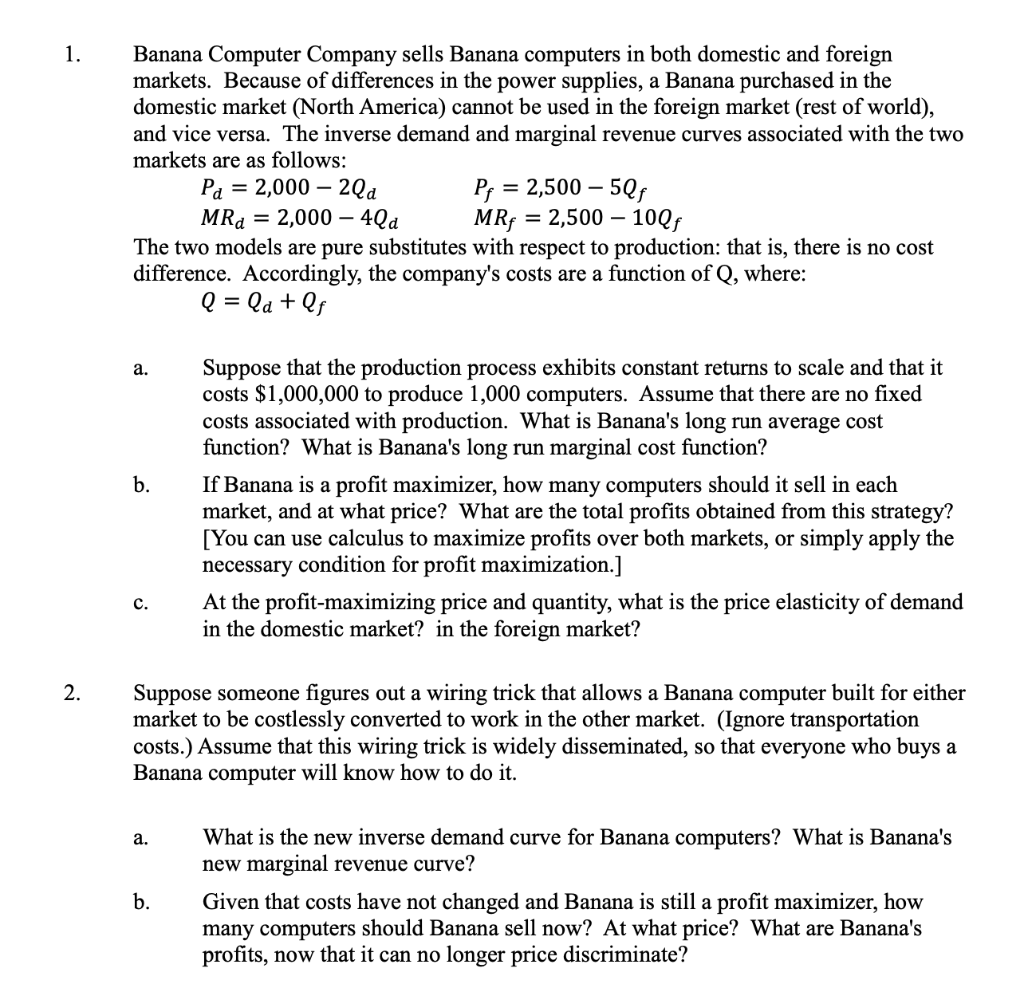
1. Banana Computer Company sells Banana computers in both domestic and foreign markets. Because of differences in the power supplies, a Banana purchased in the domestic market (North America) cannot be used in the foreign market (rest of world), and vice versa. The inverse demand and marginal revenue curves associated with the two markets are as follows: Pa = 2,000 2Qd Pr = 2,500 5Qf MRa = 2,000 4Qd MR, = 2,500 10Qf The two models are pure substitutes with respect to production: that is, there is no cost difference. Accordingly, the company's costs are a function of Q, where: Q = (a + Q f = = a. b. Suppose that the production process exhibits constant returns to scale and that it costs $1,000,000 to produce 1,000 computers. Assume that there are no fixed costs associated with production. What is Banana's long run average cost function? What is Banana's long run marginal cost function? If Banana is a profit maximizer, how many computers should it sell in each market, and at what price? What are the total profits obtained from this strategy? [You can use calculus to maximize profits over both markets, or simply apply the necessary condition for profit maximization.] At the profit-maximizing price and quantity, what is the price elasticity of demand in the domestic market? in the foreign market? c. 2. Suppose someone figures out a wiring trick that allows a Banana computer built for either market to be costlessly converted to work in the other market. (Ignore transportation costs.) Assume that this wiring trick is widely disseminated, so that everyone who buys a Banana computer will know how to do it. a. b. What is the new inverse demand curve for Banana computers? What is Banana's new marginal revenue curve? Given that costs have not changed and Banana is still a profit maximizer, how many computers should Banana sell now? At what price? What are Banana's profits, now that it can no longer price discriminate? 1. Banana Computer Company sells Banana computers in both domestic and foreign markets. Because of differences in the power supplies, a Banana purchased in the domestic market (North America) cannot be used in the foreign market (rest of world), and vice versa. The inverse demand and marginal revenue curves associated with the two markets are as follows: Pa = 2,000 2Qd Pr = 2,500 5Qf MRa = 2,000 4Qd MR, = 2,500 10Qf The two models are pure substitutes with respect to production: that is, there is no cost difference. Accordingly, the company's costs are a function of Q, where: Q = (a + Q f = = a. b. Suppose that the production process exhibits constant returns to scale and that it costs $1,000,000 to produce 1,000 computers. Assume that there are no fixed costs associated with production. What is Banana's long run average cost function? What is Banana's long run marginal cost function? If Banana is a profit maximizer, how many computers should it sell in each market, and at what price? What are the total profits obtained from this strategy? [You can use calculus to maximize profits over both markets, or simply apply the necessary condition for profit maximization.] At the profit-maximizing price and quantity, what is the price elasticity of demand in the domestic market? in the foreign market? c. 2. Suppose someone figures out a wiring trick that allows a Banana computer built for either market to be costlessly converted to work in the other market. (Ignore transportation costs.) Assume that this wiring trick is widely disseminated, so that everyone who buys a Banana computer will know how to do it. a. b. What is the new inverse demand curve for Banana computers? What is Banana's new marginal revenue curve? Given that costs have not changed and Banana is still a profit maximizer, how many computers should Banana sell now? At what price? What are Banana's profits, now that it can no longer price discriminate







